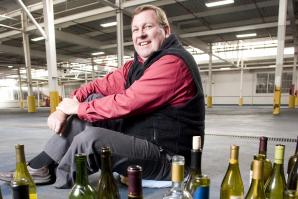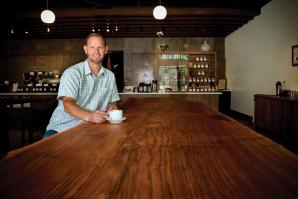Just as winemakers won’t put just any old juice in a barrel, they won’t use any old barrel either. For one wine, it’s French oak. For another, American. For yet another, Hungarian. In some cases the wine goes into a steel tank and never touches oak of any kind.
When winemakers talk about the qualities that oak imparts on wine, the terms conveniently dovetail with national stereotypes. American, they say, is a little more aggressive, more powerful. French is more subtle, delicate and elegant. Hungarian, somewhere in between.
In choosing the wood, a winemaker operates much like a chef.
“He will have to deal with the ingredients and will use different spices to achieve a very specific taste,” says François Peltereau-Villeneuve, president of Seguin Moreau Napa Cooperage. The cooper tells the winemaker what to expect from different kinds of oak, but it’s up to the winemaker to make the selection based on knowledge and experience. “It depends on what the winemaker wants to achieve: if he wants a strong impact, a low impact, if he needs tannins or he needs fruit,” he says.
There’s one more factor hiding in the background: American oak is cheaper. American oak barrels are running about $440 this year, compared to about $800 for French, depending on the exchange rate for the Euro.
American oak doesn’t have to be shipped halfway around the world to get to California, which influences cost. A bigger reason, though, is that American oak can be sawn rather than split. Its pores close naturally and eliminate any risk of leakage through cut fibers, according to the cooperage. Sawing yields about twice as many barrels from the same amount of lumber.
Price can be a big factor in how the winemaker picks the wood.
“Everybody would rather have their preferences dictate all their decisions, but you have to make money too,” says Adam Mettler, general manager at Michael-David Winery in Lodi and owner of Mettler Family Vineyards.
Michael-David produces wines that retail $10 to $60 a bottle. The top-end product is likely to get a more generous helping of French oak, Mettler says. Price is a big selling point for Hungarian, he adds: It produces a character similar to French oak for less money.
Some wineries are cutting their purchases of new barrels, Mettler says, so barrel companies are trying to hold the line on prices.
But choosing oak is about a lot more than price and national origin. It can be as complex as any other facet of winemaking. There’s the region the tree comes from, the tree’s age, how long the wood is air-dried and who builds the barrels. And then there’s “toasting,” or charring, the inside of the barrel. It can be done in different amounts and by different methods, including infrared lamps.
Seguin Moreau even sells a style of barrel with U-shaped ridges and grooves to double the surface contact between the wine and the wood.
And as far as adding flavor goes, a barrel is good for only a few years, Mettler says — though it can be good for other aspects of winemaking for years after that.
“The rule of thumb is: If I have a wine that is highly structured like a Zinfandel or a Petite Sirah, some more structure from the barrel won’t overpower anything,” says Ruggero Mastroserio, winemaker for Granite Springs and Latcham Vineyards in Somerset. “If you have a Merlot or Cabernet Sauvignon, those French varietals are more gentle. Their flavor is less spice, so they couldn’t stand the American barrels because they would be overwhelmed by the tannins. The French barrels will assure a more delicate taste.”
Wineries often mix and match barrels to get the end results they want.
St. Jorge Winery in Acampo puts its wine in and out of barrels five times before it goes into bottles, says owner Vern Vierra.
St. Jorge’s barrel program requires that one-third of barrels are brand-new, one-third are used once and the remainder are called “neutral barrels,” which are each used three or four times, Vierra says. That’s not just to save money. If it all went into new barrels, the oak taste would be so strong he’d have to throw the wine out, he says.
Each time the wine comes back out of the tank, he tastes it and tweaks the proportion of new and old oak to adjust the flavor over the course of 18 to 20 months.
It’s not quite like a recipe in which a strict formula will consistently give the same results, says Mark Grove, consulting winemaker for Jodar Winery in El Dorado. But in general his winery puts its Merlot in a 50-50 mix of American and French oak. The Barbera and Sangiovese, however, never touch oak at all as it would overwhelm the light, delicate notes. The Chardonnay is barreled in both French and American, and some is tank fermented, giving him three types to work with in crafting the final blend.
Especially at small wineries like Jodar, which don’t have a lot of resources with which to experiment, the winemaker tends to stick with a favorite approach, he says.
“Personally I like the flavor profile of many American oaks,” Grove says. “It’s just easy to overdo it.”
A winemaker’s preferences also can change as the vineyard ages. “As our vines get older, we find the need for fresh oak is diminished. A little less new oak is necessary,” says Jonathan Lachs, who, with his wife, Susan Marks, owns Cedarville Vineyard in Fair Play. Oak from eastern Tennessee or western Virginia is particularly well suited to their wines, he says, but they’ve been leaning more toward French oak lately, saying it’s “complementary to our wines and ties a nice bow around them.”
Once you know what oak can do, it’s not hard to pick up the differences when tasting a glass of wine, Lachs says. But he doesn’t see the wine-drinking public showing a big preference for one type over another. That choice is still driven by the winemaker.
Recommended For You

Euro Trash
European-style bottle reuse launches stateside
Bruce Stephens might be on to something. And if his estimates — and the optimism and faith of dozens of investors — prove accurate, his wine bottle washing company could provide a hefty return on investment, dozens of Stockton jobs and low-cost wine bottles for environment and budget-â?¨conscious wineries.

Money Tree
New Helvetia Hardwoods is homegrown
Tree aficionado Clark Kayler rescues fallen elms, walnuts, sycamores and redwoods — giants that have lined the streets of midtown Sacramento for more than 100 years — and grants them new life in the form of furniture.



